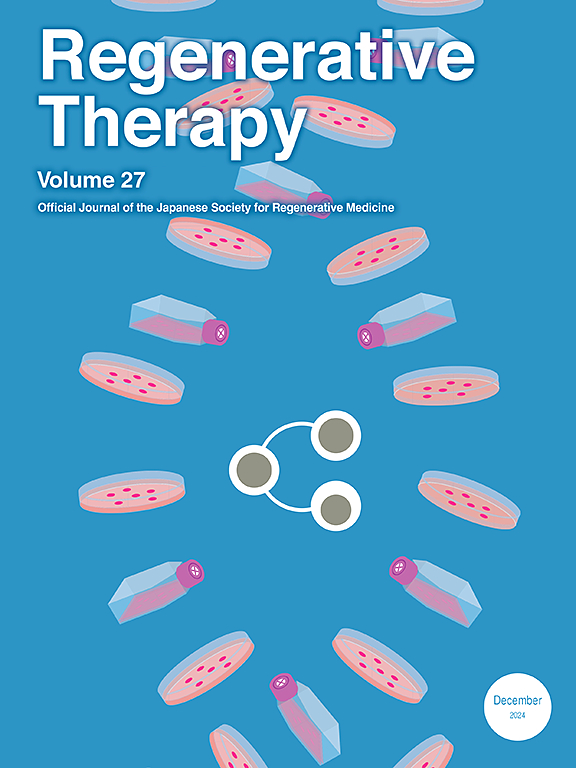过表达神经球蛋白的人神经干细胞在光血栓模型中的治疗潜力
IF 3.5
3区 环境科学与生态学
Q3 CELL & TISSUE ENGINEERING
引用次数: 0
摘要
神经红蛋白(NGB)是一种氧结合蛋白,在缺氧和缺血条件下具有神经保护作用。它促进细胞存活,减少氧化应激,激活与生存相关的信号通路。本研究旨在评价NGB在人神经干细胞(F3.NGB)中的过表达是否能增强其光血栓形成模型的再生潜能和治疗效果。方法利用基因工程技术使sf3细胞过表达NGB。使用CCK-8、菌落形成和基于划痕的伤口愈合试验评估体外增殖和迁移。在体内,使用光血栓诱导的卒中模型来评估静脉内F3移植后的梗死体积、移植细胞迁移和分化以及增殖相关信号通路的激活。NGB细胞。结果sngb过表达可显著增强F3细胞的增殖能力;在共培养条件下,NGB细胞促进N2A细胞增殖并积极迁移。体内,移植F3。与对照组相比,NGB细胞导致梗死体积显著减少。Western blot分析显示,PI3K/AKT、mTOR和ERK信号通路激活增加,PTEN表达降低。免疫组化染色证实F3。NGB细胞向梗死区迁移,分化为神经元和星形胶质细胞,Ki67呈强阳性,表明损伤部位增殖活跃。结论F3。NGB细胞主要通过增强细胞增殖来减轻缺血性脑损伤,并向损伤部位迁移并分化为神经元或星形胶质细胞。这些结果表明F3。NGB细胞为基础的治疗可能有助于发展先进的再生策略治疗缺血性卒中。本文章由计算机程序翻译,如有差异,请以英文原文为准。
The therapeutic potential of neuroglobin-overexpressing human neural stem cells in a photothrombosis model
Background
Neuroglobin (NGB) is an oxygen-binding protein with neuroprotective properties under hypoxic and ischemic conditions. It promotes cell survival, reduces oxidative stress, and activates survival-related signaling pathways. This study aimed to evaluate whether overexpression of NGB in human neural stem cells (F3.NGB) could enhance their regenerative potential and therapeutic efficacy in photothrombosis model.
Methods
F3 cells were genetically engineered to overexpress NGB. In vitro proliferation and migration were assessed using CCK-8, colony forming, and scratch-based wound healing assays. In vivo, a photothrombosis-induced stroke model was used to evaluate infarct volume, transplanted cell migration and differentiation, and activation of proliferation-related signaling pathways following intravenous transplantation of F3.NGB cells.
Results
NGB overexpression significantly enhanced the proliferative capacity of F3 cells, and F3.NGB cells promoted N2A cell proliferation and actively migrated in co-culture conditions. In vivo, transplantation of F3.NGB cells resulted in a significant reduction in infarct volume compared with that in the controls. Western blot analysis showed increased activation of PI3K/AKT, mTOR, and ERK signaling pathways, with decreased PTEN expression. Immunohistochemical staining confirmed that F3.NGB cells migrated to the infarcted region, differentiated into neurons and astrocytes, and showed strong Ki67 positivity, indicating active proliferation at the injury site.
Conclusion
These findings demonstrate that F3.NGB cells reduce ischemic brain damage primarily by enhancing cell proliferation, and also migrate to the injury site and undergo differentiation into neurons or astrocytes. These results suggest that F3.NGB cell-based therapy may contribute to the development of advanced regenerative strategies for the treatment of ischemic stroke.
求助全文
通过发布文献求助,成功后即可免费获取论文全文。
去求助
来源期刊

Regenerative Therapy
Engineering-Biomedical Engineering
CiteScore
6.00
自引率
2.30%
发文量
106
审稿时长
49 days
期刊介绍:
Regenerative Therapy is the official peer-reviewed online journal of the Japanese Society for Regenerative Medicine.
Regenerative Therapy is a multidisciplinary journal that publishes original articles and reviews of basic research, clinical translation, industrial development, and regulatory issues focusing on stem cell biology, tissue engineering, and regenerative medicine.
 求助内容:
求助内容: 应助结果提醒方式:
应助结果提醒方式:


